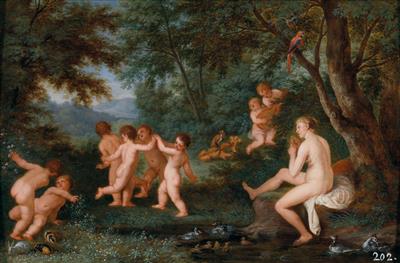Jan Brueghel II and Pieter van Avont

Jan Brueghel II (Antwerp 1601–1678) and Pieter van Avont (Malines 1600–1652 Antwerp)
Frolicking Putti with the Bath of Venus: an Allegory of Love,
an inventory number at lower right: 202,
oil on panel, 29 x 43.5 cm, framed
We are grateful to Dr. Klaus Ertz for identifying the present painting as an autograph work after examining it in the original. We also thank Professor Peter Klein, Hamburg, for carrying out a dendrochronological analysis, which allowed him to establish a date between c. 1627/28 and 1638.
Hitherto unpublished and only recently rediscovered, this painting is one of the most impressive works by the younger Brueghel – a picture which is close to the art of his father in terms of compositional elegance and painterly execution. The unusual density and the brilliant colours lend this cabinet picture an almost jewel-like character. Besides its technical brilliance, the work stands out for its unusual iconography. Here Jan Brueghel II referred to elements known from the collaboration between his father and Hans Rottenhammer, although he did not copy their components, but regrouped them, adding the figure of Venus on the right-hand side as an elegant motif which had never before occurred in his oeuvre. Thanks to this new motif, the painting, different from the previous versions of frolicking putti or children, takes on an allegorical meaning, symbolizing the concepts of love and harmony. Apart from the dancing putti (the figure of Venus was painted by Pieter van Avont), Brueghel furnished his landscape with further set pieces, including flowers, a parrot, a monkey playing on a violin and a harp, and the lute on which the amorettos in the background accompany the dance. The painting displays a Venetian influence that probably derived from contemporary prints. There may have existed a now-lost painting by Rottenhammer - as a drawing by this artist in the Museum Boijmans Van Beuningen in Rotterdam shows a very similar composition, albeit with Pan depicted instead of Venus (cf. Rottenhammer, exh. cat., Munich, 2008, p. 156, fig. 200). Jan Brueghel II contributed substantially to this composition. He conceived it and painted the landscape which elegantly expands into the left background, as well as the foliage of the forest framing the scene. The present composition reveals the artist’s great mastery in a wealth of small details.
Expert: Dr. Alexander Strasoldo
 Dr. Alexander Strasoldo
Dr. Alexander Strasoldo
+43 1 515 60 403
oldmasters@dorotheum.com
15.10.2013 - 18:00
- Dosažená cena: **
-
EUR 177.430,-
- Odhadní cena:
-
EUR 80.000,- do EUR 120.000,-
Jan Brueghel II and Pieter van Avont
Jan Brueghel II (Antwerp 1601–1678) and Pieter van Avont (Malines 1600–1652 Antwerp)
Frolicking Putti with the Bath of Venus: an Allegory of Love,
an inventory number at lower right: 202,
oil on panel, 29 x 43.5 cm, framed
We are grateful to Dr. Klaus Ertz for identifying the present painting as an autograph work after examining it in the original. We also thank Professor Peter Klein, Hamburg, for carrying out a dendrochronological analysis, which allowed him to establish a date between c. 1627/28 and 1638.
Hitherto unpublished and only recently rediscovered, this painting is one of the most impressive works by the younger Brueghel – a picture which is close to the art of his father in terms of compositional elegance and painterly execution. The unusual density and the brilliant colours lend this cabinet picture an almost jewel-like character. Besides its technical brilliance, the work stands out for its unusual iconography. Here Jan Brueghel II referred to elements known from the collaboration between his father and Hans Rottenhammer, although he did not copy their components, but regrouped them, adding the figure of Venus on the right-hand side as an elegant motif which had never before occurred in his oeuvre. Thanks to this new motif, the painting, different from the previous versions of frolicking putti or children, takes on an allegorical meaning, symbolizing the concepts of love and harmony. Apart from the dancing putti (the figure of Venus was painted by Pieter van Avont), Brueghel furnished his landscape with further set pieces, including flowers, a parrot, a monkey playing on a violin and a harp, and the lute on which the amorettos in the background accompany the dance. The painting displays a Venetian influence that probably derived from contemporary prints. There may have existed a now-lost painting by Rottenhammer - as a drawing by this artist in the Museum Boijmans Van Beuningen in Rotterdam shows a very similar composition, albeit with Pan depicted instead of Venus (cf. Rottenhammer, exh. cat., Munich, 2008, p. 156, fig. 200). Jan Brueghel II contributed substantially to this composition. He conceived it and painted the landscape which elegantly expands into the left background, as well as the foliage of the forest framing the scene. The present composition reveals the artist’s great mastery in a wealth of small details.
Expert: Dr. Alexander Strasoldo
 Dr. Alexander Strasoldo
Dr. Alexander Strasoldo
+43 1 515 60 403
oldmasters@dorotheum.com
|
Horká linka kupujících
Po-Pá: 10.00 - 17.00
old.masters@dorotheum.at +43 1 515 60 403 |
| Aukce: | Obrazy starých mistr? |
| Typ aukce: | Salónní aukce |
| Datum: | 15.10.2013 - 18:00 |
| Místo konání aukce: | Wien | Palais Dorotheum |
| Prohlídka: | 05.10. - 15.10.2013 |
** Kupní cena vč. poplatku kupujícího a DPH(Země dodání Rakousko)
Není již možné podávat příkazy ke koupi přes internet. Aukce se právě připravuje resp. byla již uskutečněna.
